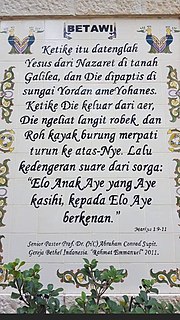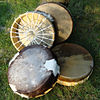A regency is an administrative division of Indonesia, directly under a province. The Indonesian term kabupaten is also sometimes translated as "municipality". Regencies and cities are divided into districts.

Pasar Minggu is a district of South Jakarta, Jakarta, Indonesia. The area is known for its traditional Sunday market, famous for the fruit market. Historically, Pasar Minggu is a fruit cultivation area developed by the Dutch government during the colonial period. The central point of the cultivation area is the traditional market of Pasar Minggu, located in what is now Pasar Minggu Kelurahan. Teak forest could also be found in Pasar Minggu district, notably around Jati Padang Kelurahan. Most of these areas has been converted into residential area as Jakarta grow southward.

Sukabumi Regency is a regency (kabupaten) in southwestern Java, as part of West Java province of Indonesia. The regency seat is located in Palabuhan Ratu, a coastal district facing the Indian Ocean. The regency fully encircles the administratively separated city of Sukabumi. Covering an area of 4,145.70 km2, the regency is the largest regency in West Java and the second largest regency on Java after the Banyuwangi Regency in East Java. The regency had a population of 2,341,409 at the 2010 Census and 2,725,450 at the 2020 Census. with a large part of it living in the northeastern part of the regency that encircles Sukabumi City, south of Mount Gede. A plan to create a new regency, the North Sukabumi Regency is currently waiting for the approval of the central government.

Cilincing is a historic neighborhood of the coast of Jakarta, Indonesia. It is sandwiched between the Port of Tanjung Priok to the west and River Titram to the east. Cilincing has been for some decades one of the districts of North Jakarta which in turn encompasses as far as Marunda and some non-coastal hinterland.

Betawi, also known as Betawi Malay, Jakartan Malay, or Batavian Malay is the spoken language of the Betawi people in Jakarta, Indonesia. It is the native language of perhaps 5 million people; a precise number is difficult to determine due to the vague use of the name.
The Batin are a sub-group of Malay people that inhabits the interior parts of Jambi province
Palembang, also known as Palembang Malay, or Musi, is a Malayic language primarily spoken in about two thirds of South Sumatra Province in Indonesia, especially along the Musi River. It consists of two separate but mutually intelligible dialect chains: Musi and Palembang. The urban Palembang dialect is a koiné that emerged in Palembang, the capital city of South Sumatra. It has become a lingua franca throughout major population centers in the province, and is often used polyglossically with Indonesian and other regional languages and dialects in the area. Since parts of South Sumatra used to be under direct Javanese rule for quite a long time, the speech varieties of Palembang and its surrounding area are significantly influenced by Javanese, down to their core vocabularies.

Ragunan is a kelurahan of Pasar Minggu Subdistrict, South Jakarta. The boundaries of Ragunan Kelurahan are Pejaten Barat Street to the north, Cilandak KKO Street to the west, Kebagusan Raya Street to the east, and Sagu Street to the south. Ragunan Kelurahan was bounded by Pejaten Barat Kelurahan to the north, Cilandak Timur Kelurhaan to the west, and Jagakarsa Kelurahan to south and to the east.

Ondel-ondel is a large puppet figure featured in Betawi folk performance of Jakarta, Indonesia. Ondel-ondel is an icon of Jakarta. Ondel-ondel are utilized for livening up festivals or for welcoming guests of honor, usually in pairs. Ondel-ondel is one of a few Indonesian folk performances that has survived modernization and is still being regularly performed.

Benteng people are a Chinese Indonesian community of 'Peranakan' or mixed descent, native to the historic Tangerang area in the modern-day Indonesian provinces of Jakarta, Banten and West Java.
Nawi Ismail was an Indonesian film director and actor. He often worked with Dicky Zulkarnaen and Benyamin Sueb.

Masjid Jami' Al-Makmur Cikini is located on Jalan Raden Saleh Raya in Cikini, Central Jakarta, and is one of the oldest mosques in the locality. It was formerly known as Tjikini Mosque.

The Cetbang refers to cannons produced and used by the Majapahit Empire (1293–1527) and other kingdoms in the Indonesian archipelago. There are 2 main types of cetbang: the eastern-style cetbang which looks like a Chinese cannon and is loaded from the front, and the western-style cetbang which is shaped like a Turkish and Portuguese cannon, loaded from the back.
In Indonesian law, the term "city" (kota) is generally defined as the second-level administrative subdivision of the Republic of Indonesia, an equivalent to regency (kabupaten). The difference between a city and a regency is that a city has non-agricultural economic activities and a dense urban population, while a regency comprises predominantly rural areas and is larger in area than a city. However, Indonesia historically had several classifications of cities.

Lancang is a type of sailing ship from Maritime Southeast Asia. It is used as warship, lighter, and as royal ship, particularly used by the people of Sumatran east coast, but can also be found in the coast of Kalimantan.

The Regent of Thousand Islands, officially the Administrative Regent of Thousand Islands, is the highest office in the regency of Thousand Islands. Unlike regents in other regencies in Indonesia, the regent is appointed directly by the governor. The regency has no regional parliament, thus making the regent responsible to the governor.
Kompang is a traditional Islamic musical instrument a kind of Rebana Origin from Ponorogo, East Java, Indonesia has been around since the 15th century. Kompang Ponorogo then spread to various areas of Malay culture in Indonesia, Singapore, Malaysia, Brunei Darussalam and Thailand which became known as Kompang Jawa.















